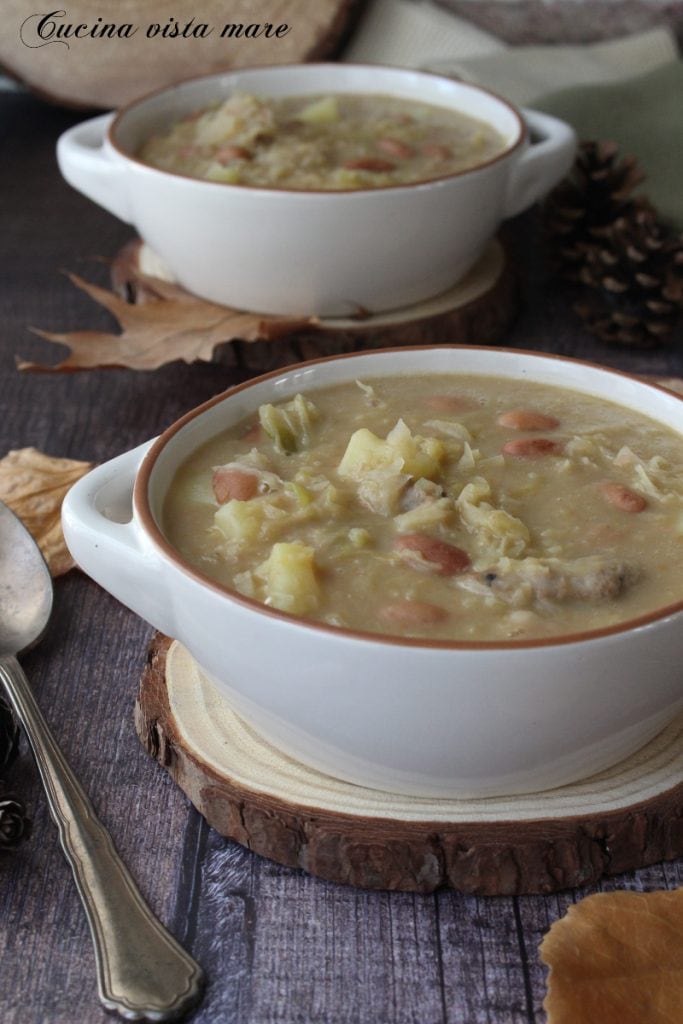The triestine jota is a warm soup, a perfect comfort food for the coldest season. Based on sauerkraut and beans, the triestine jota is an extraordinary first course. We tasted it at Mara, a family-style trattoria, in Trieste, during our short stay in the capital of Friuli, and we liked it so much that I have already replicated it several times. This is an event in my house because we never eat the same dish twice. My husband tasted it on site. I did not. I had a different dish. At home, I wanted to recreate the jota adapting it to my intolerance to cooked oil. I can use very little and raw. The triestine jota is prepared with a particular sauté, and for me, it would be impossible to eat it. When a traditional recipe is slightly adapted, we are rightly pointed out that it is not done like that, that it is not the original recipe. So I redid it following the recipe from the book “Trieste in cucina” by Rita Mazzoli and Marina Raccar but did not eat it. Try it too. I’m sure it will conquer you!
Not to miss

- Difficulty: Easy
- Cost: Economical
- Rest time: 1 Day
- Preparation time: 30 Minutes
- Portions: 4 servings
- Cooking methods: Stove
- Cuisine: Italian Regional
- Region: Friuli-Venezia Giulia
- Seasonality: Autumn, Winter
Ingredients
- 13.58 oz pre-cooked sauerkraut
- 10.58 oz dried borlotti beans
- 10.58 oz potatoes
- 10.58 oz smoked pork ribs or smoked bacon (I used smoked bacon)
- 2 tablespoons all-purpose flour
- 1 leaf bay leaf
- 1/2 teaspoon caraway seeds (caraway cumin)
- 1/2 teaspoon baking soda
- 12 tablespoons extra virgin olive oil
- to taste salt
- to taste pepper
Tools
- 1 High-sided casserole
- 1 Cast Iron Casserole
- 1 Cutting Board
- 1 Vegetable Knife
- 1 Peeler
- 1 Kenwood Hand Blender
Steps
The night before, soak the beans with half a teaspoon of baking soda.
Once the soaking time is over, rinse them and cook in cold water with peeled and diced potatoes. When beans and potatoes are ready, drain them keeping the cooking liquid aside. In a separate pot, simmer the sauerkraut covered with the reserved cooking liquid, with bay leaf and caraway seeds (I couldn’t find them here in Tuscany, so I used powdered). If the added liquid is not enough, top up with more water and cook until the liquid is absorbed. This step is necessary if using loose sauerkraut; canned ones are already cooked and just need to be heated and seasoned.
Prepare a brown roux with oil, garlic, and flour: as soon as it darkens, add the sauerkraut, stir, then add the potatoes, beans, and smoked pork or bacon or a bone or ham trimmings. Adjust the salt and let cook over low heat for 40 minutes.
To fully enjoy it, it’s better to let the jota rest. It should be prepared in the morning to enjoy it in the evening so that the flavors have time to blend and the consistency to bind. Serve the jota with a drizzle of raw extra virgin olive oil and sprinkle with a pinch of pepper.
Curiosity
The jota recipe is ancient, and as happens with most traditional recipes, it was created to satisfy the need to prepare a hearty and nutritious dish with the simple products available in the garden and pantry. The name is curious, jota, which apparently derives from the Latin jutta, meaning broth. And honestly, it somewhat fits. Because when it was served to us, the impression was precisely that, but one should not be fooled by the appearance because the jota is truly delicious. There are different versions even for this soup: in Trieste, sauerkraut is called capuzi garbi, fermented cabbage strips, and there is also pork meat (the typical Slovenian kranjska sausage, smoked with beech wood, pork ribs, or ham bone). Other versions include canned sauerkraut, sometimes much easier to find and convenient since already cooked. There is also a vegetarian version with only beans, potatoes, and cabbage. But as always with traditional recipes, every family keeps and passes down its unique and original version. As I say, what matters is the final result: an extraordinary dish.
Notes
A reader specifies (I report her exact clarifications as a Triestine: an essential element of the jota, as in Triestine bean soup, “el disfrito,” meaning a roux of flour in oil until it turns hazelnut color, stirring so it doesn’t burn at the edges of the pan. Let it cool slightly and pour it into the jota while cooking. Potatoes can also be boiled whole and coarsely mashed. Borlotti or dark beans. The jota should be brownish and thick. No vegetable broth is used. It’s better to use smoked bacon or pork ribs instead of the common sausage found in supermarkets or butcher shops, if kranjska sausage can’t be found.
When it comes to preparing traditional dishes, I always do research. For typical dishes, there is no invention. The recipe is the recipe. However, different versions can be found. As I always say, and as specified here, every family, every restaurant, has its recipe. Even online, searching specialty Friulian sites, I found different versions. The same jota we ordered in the restaurant was far from thick, so much so that we really thought it was a “broth”: a lot of broth and few ingredients. After studying and purchasing a book of Triestine recipes, I decided to modify the initial version adapted to my intolerances and offer you one that closely resembles the original recipe. I was very sorry not to be able to taste it, but the brown roux is too much for me.

